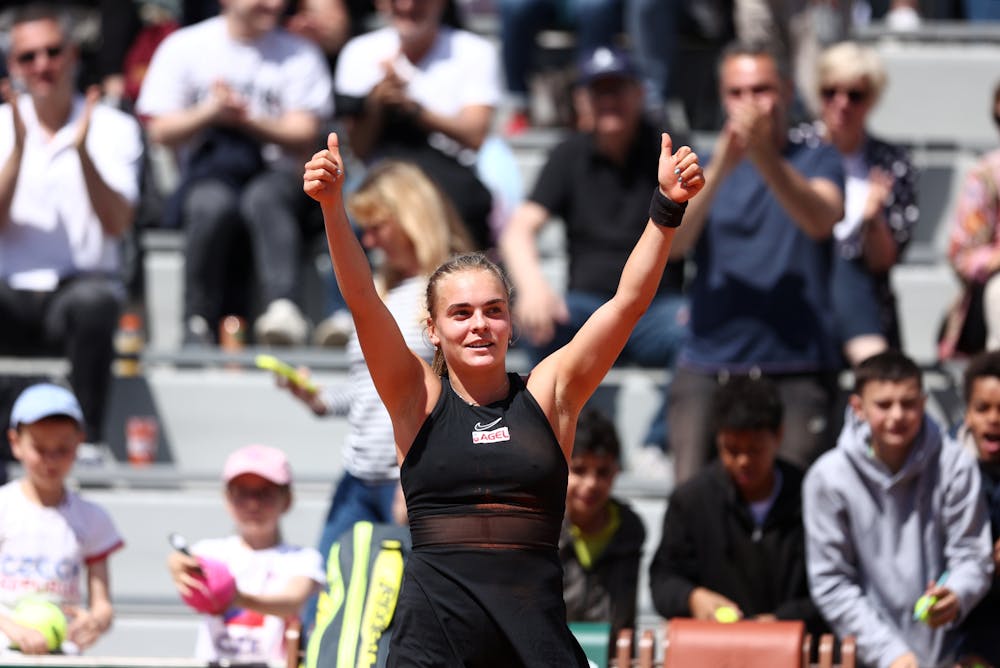Every day at Roland-Garros the talented French Tennis Federation (FFT) photographers are out snapping around the grounds, but not many manage to catch a player levitating.
Bejlek inspires different type of shot
Czech qualifier Sara Bejlek, who made the second round at RG for the first time, also played a part in one of the photographs of the tournament so far
 ©André Ferreira / FFT
©André Ferreira / FFTAndre Ferreira is part of the photographer pool and the man to praise for the astonishing picture above; Czech teenager Sara Bejlek is the athlete in the frame.
It was taken during the 19-year-old’s successful qualifying campaign at Roland-Garros 2025. After that, Bejlek stunned No.26 seed Marta Kostyuk 6-3, 6-1 to post her best Grand Slam run to date.
For Bejlek, this photo captured how hard it is to compete on clay at the very highest level. It’s a surface you have to sacrifice on, suffer on.
“I lost the point,” Bejlek recalled looking at the picture. “But, it shows my fight in every point.
“I’m happy I didn’t get injured when I see this picture. Because the right wrist doesn’t look like it should.”
Perhaps the world No.188 was inspired by her background in a different sport.
“I did some gymnastics when I was very small, the floor - I tried everything," Bejlek said. "Definitely not any more. My parents got me to try it, but I was the worst one in the class.”
“Roland-Garros is a very special place for me, I played my first Grand Slam here as a junior (2022 singles semi-finals, 2022 doubles champion), now I also did very well here in the pros,” added Bejlek, who narrowly missed out to Jaqueline Cristian 1-6, 6-3, 6-3 on Wednesday.
“Like this picture, like these times in Paris, I think I’ll always be a player for clay.”
 ©André Ferreira / FFT
©André Ferreira / FFTSara Bejlek celebrates her third round qualifying victory
Over to Ferreira for his perspective on his remarkable picture.
“As soon as I looked at my screen after this burst of pictures, this one immediately looked dramatic, with the whole hand on the floor and the body levitating out,” he said.
“It’s a special one, because this kind of action doesn’t happen very often in tennis. They fall, but they don’t fly.
“I was kind of lucky, I had the right lens for it, at the right time. Ten seconds before, I had another lens, trying to do close-up shots. This one I had a 300ml lens; it was perfect.
“I remember she won that particular game, she deserved it as that photo shows she was really fighting for it.”
Reel back to 2014 and Ferreira switched up his career as a radio journalist to embrace his passion for photography. Being in the thick of the action is an essential element for the Portuguese-born Parisian.
“Radio was good, the live adrenaline was very fun. Since I was presenting the news, I spent all my time at the studio and I was missing going out to see the stories, what was happening outside,” he said.
“I wanted to stay in journalism, so I thought photography, which I already liked before, would be the path.”
A photojournalism masters course later and he was sent to capture tennis for the first time at Roland-Garros 2016.
“I worked for a photography news agency and at the time I wasn’t much into tennis. I knew the big names, but I remember all my colleagues wanted to come here to shoot,” Ferreira admitted.
“In 2016, I wasn’t overly excited, it was just another job. As soon as I arrived, I understood why all my colleagues loved it here. It rained a lot that year, yet you got a feeling of the true Roland-Garros, the magic.”
For the FFT photo squad, these Porte d’Auteuil grounds are the ideal canvas for texture and layers in their pictures, just like the one of Bejlek.
“It’s a special event. When you have nice light, you can get very creative,” continued Ferreira, who moved to the French capital in 2008.
“You work here for three weeks. Say a football match, it’s over in one night. Here you can try things, if it doesn’t work you can come back tomorrow to try again.
“I like Court Simonne-Mathieu very much. It’s beautiful. You can play a lot with the architecture of the place, the sun and light gives a lot of different shades. There are reflections off the glass, the (greenhouse) roof, it’s stunning.
“You have so many courts here and they are all different. It means you can try different things and angles, there are so many different spots to look up and down, so many lovely backgrounds.
“At Roland-Garros you have this freedom, unlike other venues, unlike other sports. It’s the perfect place to come and to work as a photographer.”
 ROLAND-GARROS
18 May - 7 June 2026
ROLAND-GARROS
18 May - 7 June 2026

